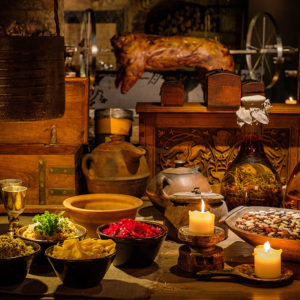ON THE TRACK OF FLORENCE IN THE MIDDLE-AGE WITH ITS ARTISANS, BLACKSMITHS AND TRADITIONAL FLORENTINE CUISINE
Where did the Florentines of the 12th century use to go if they wanted to drink a barley water or savour the julep fruit? Surely by Valenti, one of the most famous and popular medieval shops in Florence. Valenti stood in the heart of the Old Market, on the corner of Via Calimala. Today this commercial space serves acetose and melon gouache. Orzata is a barley drink comparable to almond milk: it is very refreshing and is obtained from the pressing of seeds, grains, tubers, nuts or fruits. While the giulebbe was a syrup of Persian origin made of rose water, sugar and fruit, excellent when served cold, but also used to preserve fruit (pears in julep, a delicacy). Among the Florentines of that period it was popular to stop in the Valenti’s shop, even though the whole area of the Old Market was very run down.
Today Republic Square is the hub of Florence nightlife, with its trendy shops, fine Cafès and classy restaurants. In the Middle Ages it was one of the worst areas of the city: with poorly maintained buildings and unsafe brothels. There was also the old Jewish Ghetto, which was destroyed in 18th century during the reconstruction of Florence. The whole area was built on the ruins of the Roman colony Florentia: the Capitol, the Forum and the ancient baths developed around the cardo maximus (form via Roma to via Calimala) and the decumanus maximus (from via Strozzi to Via degli Speziali), the main streets of the city.Next to the building of the Wool Guild there were blacksmiths and artisans, while on the opposite side there were the typical food stalls. Roventini (made with pig’s blood, flour and lard), sommommoli (rice fritters dusted with sugar), gnocchi, artichokes and zucchini flowers were the delicacies of the time. Even today we can find solid traces of the Florentine tradition, although it is increasingly difficult to find taverns and restaurants that offer these foods. A speciality was fried apples, a sweet and tasty delicacy. In short, the fried food was and still is a symbol of Florentine cuisine: who does not appreciate the fried flowers or the artichokes, served to outline a large fritto dell’aia, a simple but tasty dish whose name comes from the custom of farmers to cook the meat of chickens and rabbits. The cooks would scream out to customers, a bit like today in the market stalls of Sant’ambrogio. The Old Market was filled with a penetrating smells. It was the effect of the torches or oil lamps that was used to illuminate the merchandise, so much that often it created a kind of fog everywhere.
Moving to the Oltarno area accross the Old Bridge, in Piazza Santa Felicita, near the column dedicated to the enterprices of St. Peter Martyr against the heretical Cathars, the scenario changed: there were sellers of lamb, tripe,and various inners. Even today some tourists horrified by the idea to taste the sandwich with the fifth quarter, which is the fourth stomach of the cow, imaging a whole lamb’s head, including teeth! Among the many curiosities of that time it is worth remembering also the Osteria della Cervia, which offered accommodation and also was in via degli Speziali. Francesco from Dicomano, said Tonino, was the host of Cervia. His name appears in a register of the Tithes (a taxes register) together with that of the perfumer Bernardo. The Osteria della Cervia is basically the forerunner of all the hotels in Florence. In fact it is only in the sixteenth century that will open the Falcone Hotel, a business a bit more similar to the current hotel facilities.
Let’s end our tour in Orsammichele were butchers had there place it is far beyond imagination that surround the place. Around Sant’Andrea they were selling not only fruits and vegetables, as well as Small green balls made of spinach, chard and mixed herbs are still very present in the Florentine table, along with chickpeas and cannellini beans The florentine cod (with tomato, garlic and parsley) is still a dish much appreciated by the Florentines and often offert in taverns and restaurants.
Enjoy your Medieval walk in FLorence and do not hesitate to contact LET’S WED! for your venue or your concierge service to help you discovering with us the beauties of our Renaissance City!
Arrivederci a presto!




